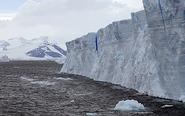
The journal Nature published a paper on Feb. 9 co-authored by Eugene Domack, the J. W. Johnson Family Professor of Environmental Studies; alumna Amelia Shevenell ’96, his former student who is now a lecturer at the University College London; Anitra Ingalls, University of Washington professor; and C. Kelly, a University of Washington graduate. Titled “Holocene Southern Ocean surface temperature variability west of the Antarctic Peninsula,” the paper is also featured in the journal’s News and Views section which highlights papers of special note.
Domack has continued to work with Shevenell, for whom he served as Hamilton advisor, during the last 15 years. Shevenell, the paper's principal author, performed the work related to the paper as a post doctoral fellow at the University of Washington in Ingall's lab.
The journal’s announcement of this paper explains that the Antarctic Peninsula is one of the fastest-warming places on Earth, experiencing dramatic regional climate change in recent decades, especially during La Niña years. The long-term variability of the peninsula’s climate, however, has remained unclear, limiting researchers’ ability to evaluate ongoing changes in a historical context and to understand what part underlying forcing mechanisms might play.
The authors presented data from a marine sediment core, having reconstructed sea surface temperatures over the past 12,000 years. The data showed that long-term cooling of 3 to 4 degrees Celsius occurred in waters near the tip of the peninsula and was related to changes in local insolation, but that short-term variability was strongly influenced by westerly winds. The authors proposed that the present influence of the El Niño/Southern Oscillation (ENSO) system on the Antarctic Peninsula may have developed only over the past 2,000 years They suggested that if ENSO increases in strength and frequency and the westerly winds move south and intensify, as expected from future climatic warming, this connection may strengthen, with implications for Antarctic ice-sheet stability and sea-level rise.
According to Domack, “Studies such as ours highlight the need to include ocean changes forced by winds and storms in current models for warming conditions in the Antarctic Peninsula region. This study also lays the groundwork for application of this method, of paleotemperature estimation, to other sediment archives around the Antarctic margin.”
